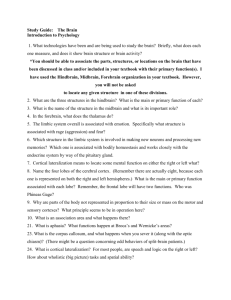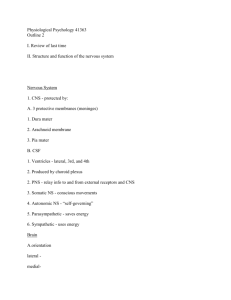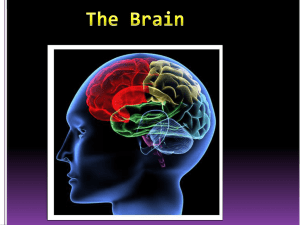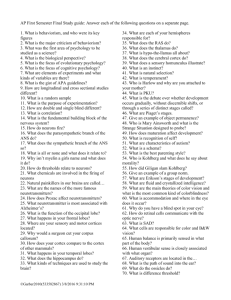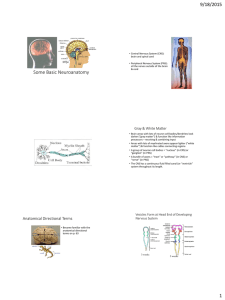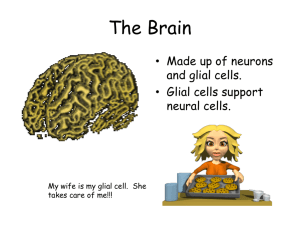9.01 - Neuroscience & Behavior Fall 2003 Massachusetts Institute of Technology
advertisement
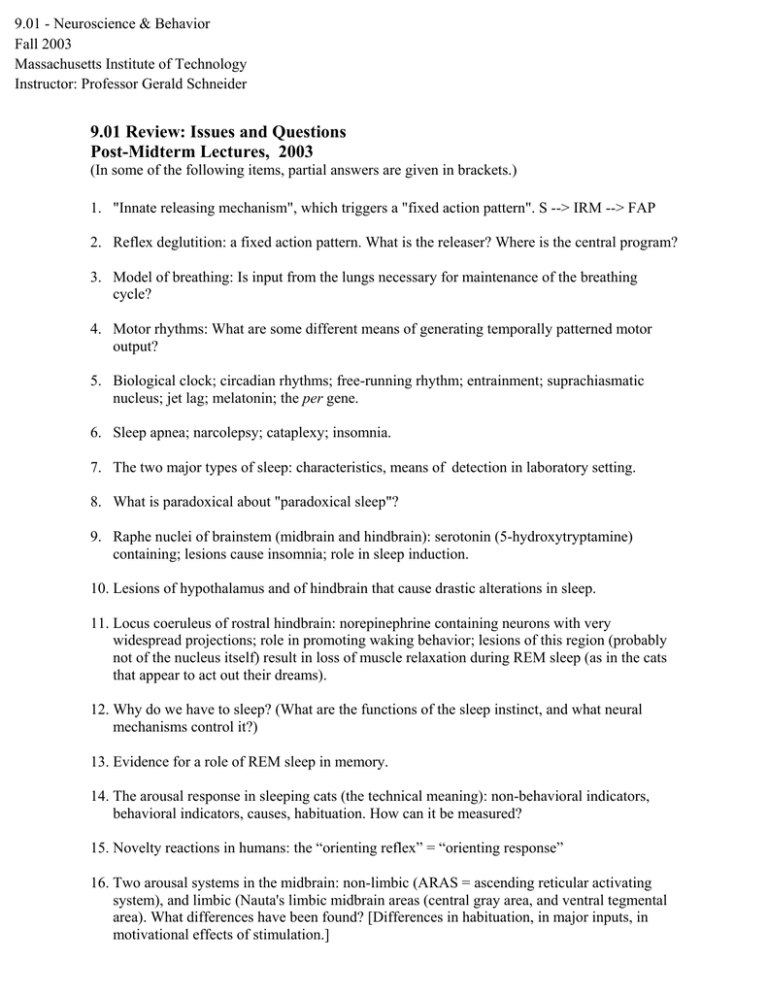
9.01 - Neuroscience & Behavior Fall 2003 Massachusetts Institute of Technology Instructor: Professor Gerald Schneider 9.01 Review: Issues and Questions Post-Midterm Lectures, 2003 (In some of the following items, partial answers are given in brackets.) 1. "Innate releasing mechanism", which triggers a "fixed action pattern". S --> IRM --> FAP 2. Reflex deglutition: a fixed action pattern. What is the releaser? Where is the central program? 3. Model of breathing: Is input from the lungs necessary for maintenance of the breathing cycle? 4. Motor rhythms: What are some different means of generating temporally patterned motor output? 5. Biological clock; circadian rhythms; free-running rhythm; entrainment; suprachiasmatic nucleus; jet lag; melatonin; the per gene. 6. Sleep apnea; narcolepsy; cataplexy; insomnia. 7. The two major types of sleep: characteristics, means of detection in laboratory setting. 8. What is paradoxical about "paradoxical sleep"? 9. Raphe nuclei of brainstem (midbrain and hindbrain): serotonin (5-hydroxytryptamine) containing; lesions cause insomnia; role in sleep induction. 10. Lesions of hypothalamus and of hindbrain that cause drastic alterations in sleep. 11. Locus coeruleus of rostral hindbrain: norepinephrine containing neurons with very widespread projections; role in promoting waking behavior; lesions of this region (probably not of the nucleus itself) result in loss of muscle relaxation during REM sleep (as in the cats that appear to act out their dreams). 12. Why do we have to sleep? (What are the functions of the sleep instinct, and what neural mechanisms control it?) 13. Evidence for a role of REM sleep in memory. 14. The arousal response in sleeping cats (the technical meaning): non-behavioral indicators, behavioral indicators, causes, habituation. How can it be measured? 15. Novelty reactions in humans: the “orienting reflex” = “orienting response” 16. Two arousal systems in the midbrain: non-limbic (ARAS = ascending reticular activating system), and limbic (Nauta's limbic midbrain areas (central gray area, and ventral tegmental area). What differences have been found? [Differences in habituation, in major inputs, in motivational effects of stimulation.] 17. Models of habituation: central adaptation (self-generated depression at central synapses); Sokolov's comparison system (model of expected inputs compared with actual inputs; difference results in arousal response -- in brain and in behavioral outputs). Most studies have focused on the first model. Kandel and associates have obtained evidence for a localized engram for habituation memory at specific synapses in the sea slug (Aplysia). 18. Multiple parallel pathways and channels and systems: What are the meanings of these terms? Give examples: for a single system, like the somatosensory or visual or auditory system, as well as for the whole organism. 19. Subcortical visual systems: What is the major structure in most vertebrates? (superior colliculus = optic tectum of midbrain). Comment on interspecies differences in visual system structures. [Same pattern of optic-tract connections, same basic structures, but large differences in relative sizes of different structures and in cytoarchitectural details]. 20. Contrast the behavioral effects of visual cortex ablation and superior colliculus ablation in hamsters. (Explain the “double dissociation” obtained in lesion studies). 21. What are the two major functions of the superior colliculus indicated by lesions studies of adult rats and hamsters? 22. Why do neonatal lesions of the superior colliculus in hamsters have effects that are different from the effects of lesions in adults? Give an example of a difference. 23. What is "blindsight" in monkeys or humans? How is it measured/characterized? Why is it so fascinating to people, and so controversial? 24. Describe a phenomenon of anatomical plasticity after a brain lesion, and a functional correlate. 25. Describe a phenomenon of anatomical plasticity not involving a brain lesion, e.g., describe an effect of visual deprivation on brain anatomy and/or physiology. 26. What brain damage could result in total blindness in tests of visually guided movements, yet spare some response to light? Describe two tests of vision and also the spared response. 27. What is the basic function of vision that a. depends on the retinohypothalamic projection? b. depends on the visual pathways to the superior colliculus? c. depends on the visual pathways to the lateral geniculate nucleus of the thalamus? 28. "Corticotectal diaschisis": Describe the Sprague effect in cats, and why it is interpreted as a diaschisis effect. 29. Describe the connections of the 5 major cell types of the vertebrate retina: Name the cell types, and indicate which connects to which. Which cells fire action potentials? Which cells have axons in the optic nerve? 30. Retinal ganglion cell receptive field properties: Species differences related to number of amacrine cell connections with ganglion cells compared to bipolar cell connections with ganglion cells. 31. Describe the properties of receptive fields for two neocortical cells, one in the "primary" visual cortex (striate cortex = area 17) and one in an extrastriate area. 32. What is “cascade specification”? 33. What is “magnification” in sensory maps in the brain, and with what function is it correlated? 34. How can the visual cortex be disconnected from the inferotemporal cortex, sparing highacuity discrimination of simple visual patterns, but causing impairment in difficult visual shape discrimination (the Mishkin experiment)? 35. Compare this to the human disconnection syndrome that abolished a person’s ability to read words in a case described by Geschwind and Kaplan. (This case study gave a major impetus to modern studies of "split brain" patients.) 36. What are the major cues for localization of an auditory stimulus detectable by the CNS? Describe the connections and role of the neurons of nucleus laminaris of chicks (= medial nucleus of the superior olive in mammals). [coincidence detectors…] 37. Two ascending auditory system pathways, one of which connects to SC: What functions are separated in the two pathways? 38. Auditory pattern detection by neurons in the auditory cortex: Give examples. 39. What are tonotopic maps and where are they found? [in the cochlear nuclei, inferior colliculus, medial geniculate body, and auditory neocortex]. 40. Birdsong: Sexual dimorphisms in canary brain; seasonal changes; hemispheric specialization. 41. What is meant by the "labeled line theory" of pain perception? Describe a phenomenon that reveals its limitation in fully explaining some of the phenomena of pain perception. 42. Brown-Sequárd syndrome: Describe the lesion and the resulting symptoms. 43. What can cause a congenital absence of the ability to perceive pain from somatic inputs? [Congenital absence of C fibers, the smallest, and unmyelinated, fibers of the dorsal roots.] 44. Consider the following: a) a large diameter fiber from a cutaneous afferent receptor to the spinal cord, b) a small-diameter afferent fiber of a spinal root. Describe the effects of activity in each fiber on a dorsal horn cell that has an axon in the spinothalamic tract, according to the "gate-control theory" of Melzack and Wall. 45. Why does a person usually perceive a limb (a "phantom limb") after the actual limb has been amputated? Such limbs often have intractable (very difficult or impossible to control) pain. 46. Name an intractable pain condition. How can it be treated? [Phantom limb pain; causalgia after regeneration of a peripheral nerve; "intractable" means that it cannot be successfully treated, but many methods have transient success, e.g., lesions of spinothalamic tract.] 47. What is referred pain? Give an example. [Heart damage: pain felt in shoulder and upper arm. Inflammation of ovaries or other pelvic organs: pain may be felt in lower back.] 48. What are endorphins, and what phenomena might they help explain? [Endogenous opioids; stress-induced analgesia, and some acupuncture effects.] 49. Describe effects of electrical stimulation of the central gray substance of the midbrain, on pain perception and on emotions and motivational state. 50. Fröhlich's Syndrome (gonadal atrophy; overeating --> obesity; irritability; finicky eating). Describe experiments with rats that helped explain it. 51. Hypothalamic lesions and weight regulation: Contrast medial lesions affecting descending axons from the paraventricular nucleus, with lesions of the lateral hypothalamic nucleus (which destroy many axons of the medial forebrain bundle). 52. Electrically elicited drive states: examples of effects of stimulation of the hypothalamus through implanted devices. [In class, we described motivated behavior related to temperature regulation, escape from predators, hunger, predatory aggression, irritable aggression.] 53. Describe some of the cues indicating satiety in feeding. How was evidence for an important role of blood-borne factors first obtained? 54. How can we be sure that "quiet, biting attack" in cats is an innate "fixed action pattern" (or a small group of FAPs)? Use neurophysiological evidence. 55. Contrast appetitive and consummatory behavior. 56. Drives have been explained in behavioral scientists' theories in terms of activity that can build up in brain modules. Konrad Lorenz' "action specific potential" and Peter Milner's " central motive state" refer to activity in a group of neurons with multiple inputs, and with widespread outputs that modulate various sensorimotor connections, and which also influence general arousal systems. Many different groups of neurons like this exist in the limbic forebrain and midbrain, the central components of motivational states. What are some of the innate drives? Also describe some learned motivations. 57. What is some evidence for reward circuits in the brain? Describe ICSS = intracranial selfstimulation? The text describes evidence linking reward effects to dopamine-containing axon pathways. Where are the cell bodies of these axons? 58. Describe specific evidence that limbic forebrain structures are important in emotion. [Lesion effects, effects of seizure activity or electrical stimulation, effects of drugs.] 59. Compare hemispheric dominance for affective components of perception and for language abilities. [Recall the test invented by Julian Jaynes given to the class, in which righthemisphere dominance was indicated for about 80% of people]. 60. What is some specific evidence that the limbic forebrain is important in learning. [Hippocampal formation studies; role of the basal forebrain which loses ACh containing neurons in Alzheimer's Disease -- neurons with widespread connections to neocortex; role of reinforcement – reward -- mechanisms.] 61. What is the difference between a “synthetic character” and a robot? [We did not see the video this year. If you are interested, let me know. Synthetic characters are “autonomous” characters that appear on a computer monitor.] 62. Distinguish four levels of the limbic system, from lower to higher: a. Hypothalamus and limbic midbrain, connected by medial forebrain bundle and by fibers between the CGA and the posterior hypothalamic area. b. Olfactory structures, septal area and basal forebrain, amygdala, hippocampal formation. c. Cingulate gyrus and parahippocampal gyrus (sometimes called, together, the limbic lobe). d. Orbital prefrontal neocortex. 63. What is some evidence for dissociation of neural mechanisms in short vs. long-term memory? 64. Consolidation in memory formation: Define and describe evidence for it. (E.g., effects of electroconvulsive shock.) 65. Self-identification and effects of artificial manipulation of the brain. What are some means of such artificial manipulation? 66. Describe evidence that a split-brain patient has two major, separate organs of consciousness. 67. Evidence that people without brain damage have brains that are not always unified: Cite pathological states. Cite also non-pathological behavior. 68. What is "automatic writing"? Relate this to hypnosis states, and to split-brain phenomena. 69. Is the language system necessary for higher cognitive functions? Discuss. 70. Disconnection syndromes: Describe specific examples. [In class we discussed the Mishkin and Ungerleider experiments on monkeys and inferotemporal cortex, the Geschwind and Kaplan human case, split brain patients, effects of undercutting or ablating the superior colliculus; see also readings]. 71. The case of H.M. led to two major dissociations in the study of memory. What are they? [Short-term memory vs. long-term memory; episodic vs. procedural memories, also described as declarative vs. non-declarative memory.]
